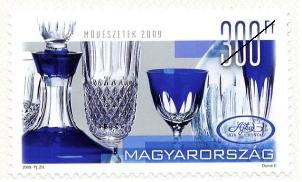THE ARTS 2009 (2) Ajka crystal glass
Date of issue: 28 October 2009

The history of Ajka crystal glass began in the middle of the 19th century in the glass kilns in the forests of the Bakony Hills. In 1878 Bernát Neumann brought glass-makers from Bavaria and Saxony to Ajka, where he had established a manufactory, still operating today, to work alongside local glass trade craftsmen. According to an 1879 treasury report, concave glass, ordinary glass and lamp chimneys were made there. In 1891 the works came into the hands of the financially strong company Kossuch. In this period Ajka glass was already traded in Germany, East India and North America. The factory ceased production in 1914 due to a shortage of labour, and restarted in March 1916, lighting a single furnace. The supply of raw materials was problematic after the Second World War and lack of coal brought production to a standstill once more. Operations were resumed in October 1946 and the works was nationalized in 1948. In the 1960s and 1970s the factory floor was expanded and the making of lead crystal began. Generator gas was substituted by natural gas for firing, while the potter’s kilns were replaced by bath furnaces ensuring continuous melting. After privatisation in 1990, technical development on an unprecedented scale and dynamic growth in production typified the business. Since then, environment friendly electric glass melting that ensures high-quality glass has been introduced along with combined colour products and hand painted glass. In order to increase production, a second facility specializing in making potash crystal was built in Ajkacsinger. A studio for porcelain painting at artistic standards was opened in 1991. 96% of Ajka products are exported, mainly to the United States of America and Western Europe, but Ajka glass is also popular in Japan and South-East Asia. (Source: ajka-crystal.hu)Details of superbly crafted examples of Ajka crystal with great artistic merit made in clear, polished, painted and colour-combined glass are shown on the special postage stamp and its first day cover – glasses, goblets, decanters, jugs, dishes and glass ornaments. The design of the postmark employs the stylised form of a piece of crystal glass.
SO
Order code: 2009210010011 (stamp) – 2009210060012 (FDC)
Date of issue: 28 October 2009
Printed by Pénzjegynyomda
Designed by Eszter Domé
Perforated size: 50 x 30 mm, 50 stamps/sheet
300,000 copies are to be issued.
More information:
philately@posta.hu
www.posta.hu

